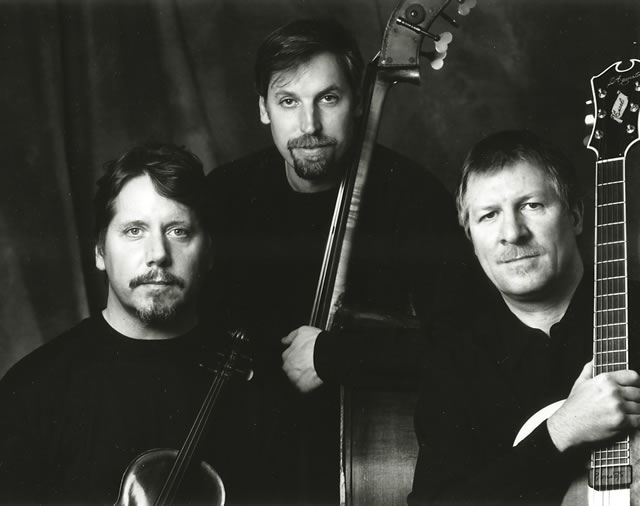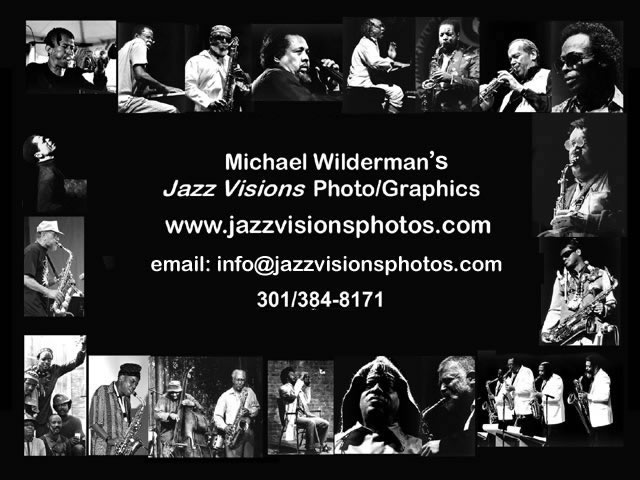Far Cry
a column by
Brian Morton

String Trio of New York Gordon R. Wenzel©2008
Between 1947 and 1953, the United States gave succor to Europe. Thirty years later, the roles were reversed, at least where jazz was concerned. It was like the Marshall Plan in reverse. The urgency of post-war aid was sharpened by some of the harshest winters on record, but they were nothing to the cold winds that froze jazz recording on the bough in the early 1970s. In the role of Secretary of State George Marshall, step forward Giacomo Pilliciotti, founder in 1975 of Black Saint records, based in Tribiano, Italy, about a half hour’s ride south east of Milan.
Tenor saxophonist Billy Harper’s Black Saint (BSR 001) marks a small epoch in modern jazz, the launch of an imprint that in time would give a voice to Muhal Richard Abrams, Amina Claudine Myers, David Murray, Bill Dixon, Karl Berger, Archie Shepp, Andrew Hill, Keshavan Maslak, Old and New Dreams, Cecil Taylor, Sun Ra and George E. Lewis. After a certain point, the list becomes redundantly – or embarrassingly – long. The American avant-garde, which had shipped out to Paris at the start of the decade, seemed to have shifted its scene of operations to Milan by its middle. The label’s own epochs are simply enough stated. Giovanni Bonandrini took over its running in 1977, founded the Soul Note imprint in 1979 – ostensibly to service more ‘mainstream’ repertoire though the distinction is scholastic, and significantly it was Billy Harper again who launched the new list – and later gave way to his son Flavio, who continued to produce new recordings. Or at least, he did until the recent announcement that Black Saint and Soul Note had been sold to Cam Jazz, a burgeoning imprint already producing some of the most elegant and thoughtful jazz coming out of Europe. One hopes – and the hope is heightened by word that Flavio Bonandrini will continue in a consultant’s role - this marks a new initiative rather than a quietus. The imprints’ history is too valuable to interrupt, let alone cease.
I was once pressed, during a live radio interview, for what I considered to be the most “important” – no time on a live show to wonder what that really means – of Black Saint/Soul Note’s releases. I surprised myself somewhat by saying “String Trio of New York, Rebirth of a Feeling.” This was in the mid-80s. If I’d been asked a decade or so later, it might have been Faze Phour, a decade after that it would certainly have been The River of Orion: Thirty Years Running, which marks a certain epoch for the trio as well.
So, here’s a group with no saxophones, no other horns, no drummer, and you’re suggesting it’s one of the most important jazz ensembles of recent time? Yeah, and with every successive release, that impression is reinforced. I’ve enlarged elsewhere on the historical dimensions of this. The early “jazz” bands grew out of plantation groups that would certainly have had a fiddle, a mandolin, or guitar and banjo, maybe a stand-up bass viol of some sort, no clarinets or saxophones, and certainly no drums. So there’s nothing inherently absurd about the STNY instrumentation in this idiom.
The group was founded – as a “maniacal” duo – by guitarist James Emery and bassist John Lindberg. Their empathetic playing and ability to swing caught the ear of violinist Billy Bang, who quickly joined up and brought with him some essential element that clinched a group identity. The Emery/Lindberg axis has remained in place ever since, though the violin has been a bit of a revolving door and the only aspect of the group’s make-up that has significantly affected its quality.
Typically, Lindberg holds the centre, with Emery replicating part of the banjo’s old role of percussive pulse, and Bang and his successors playing a wild and unfettered melody over the top. In 2007, STNY were the opening act at a Viennese festival called Atypical Jazz. That’s accurate and misleading in equal measure. Over the years the group has become increasingly original and sui generis, but its roots have never been disturbed: they’re deep and unshakeable. In 1983 Emery told me, “It took no time at all to realize that we had something different and quite special going on. I guess we recognized it after playing together for just a few minutes.”
Twenty five years after that, with Rob Thomas now playing violin for the group, the new album underlines that “special” quality. “The River of Orion” is one of Emery’s most remarkable conceptions, a collection of themes that seems to take in swing, folk, European classical forms, koto and oud music, and some strange syncretism of Levantine and Nilotic influences. Whatever the lineage, it’s unique – strange, but not unduly alienating, melodic, but hardly wedded to song, percussive and metrical in the most individual way. The album’s other pillar is Lindberg’s “Journey Platz,” a more abstract conception based on graphic elements but further sign that Lindy Publishing is the source of some of the most exciting – and, yes, important – jazz composition of recent times. Why aren’t these guys more widely appreciated, you have to ask? Unfortunately, the answer is obvious: because they play fiddles and things. Same reason why Milt Jackson and Bobby Hutcherson aren’t spoken of in the same breath as John Coltrane.
STNY’s debut recording First String (re)introduced a fresh and flexible sound to jazz. Black Saint gave the cover an unambiguous ‘period’ theme, with a sepia photograph surrounded by Art Deco borders. So what would the first listeners have made of “song” titles that mentioned ‘catharsis’ and name-checked one of the most obscure figures of the 1960s avant-garde Giuseppi Logan? What expectations would they have brought to a piece like “East Side Suite”? Four more albums followed in a similar vein, featuring open-hearted improvisation on challenging themes and played without the usual baggage of “front-line” and “rhythm section.” That, more than anything is what makes STNY important and the ancestor – witting or unwitting - of contemporary groups like trumpeter Peter Evans’ or guitarist Mary Halvorson’s, where the familiar relation between “horns” and rhythm has been radically recast.
In 1986, Bang left the group to pursue other projects, and some admirers felt that might be the end of the road. The violinist was certainly the most dramatic performer, but even then it was clear that Lindberg and Emery – the original axis – were more than resilient enough to sustain the change and new personnel. Bang was replaced first with Charles Burnham, at first hearing a less vociferous player, and thus perhaps better placed than Bang to point up the group’s delicate balance of centripetal and centrifugal energies. Five years later, Burham was in turn replaced by Regina Carter, who brought a new and exciting quality to the group. Intermobility and Octagon were the strongest STNY albums for some time – play Emery’s “The Pursuit of Happiness” (which opens the latter) to a classical guy some time and see if he can guess who it is – with some of the early fire rekindled. More and more, the group seemed to be playing material from the jazz repertory, not because there was any drying up of compositional ideas – quite the reverse, I’d suggest – but because the themes they covered simply had never been performed by a group of this configuration. Intermobility included themes by Bud Powell and Charlie Parker (whose career dream had been to play with strings), by Monk and Herbie Nichols, Wayne Shorter and Eric Dolphy, and by Ornette Coleman, who had, of course, added a fiddle to his own armory two decades before. Here was music that, in the old parlance, was both inside and outside, radical and in the most meaningful sense conservative.
Jazz is always best considered a verb rather than a noun. That way, there is no chance of missing that what STNY do is jazz in quintessence. In the autumn of 1993, Blues…? interrogated another of the fundamental bases of the music, a set that included original compositions by all three members, as well as a medley of Parker tunes, an Ellington obscurity “I’m Afraid” (which even the Duke may have overlooked once the ink was dry) as well as fine interpretations of Lee Morgan’s “Speedball” and Miles Davis’s “Freddie Freeloader,” recast in strikingly elegiac form. Reviews routinely referred to the “unusual instrumentation,” like Dr Johnson commenting on the dog that walks on its hind legs.
It’s misleading to suggest that STNY themselves are in any way hung up on the dubious concept of jazz-as-process. Though much of the group’s work is challenging – generically, technically – it has an almost physical immediacy of impact, reasserted on the new record. One wouldn’t necessarily want to dance to it, particularly when different strings are playing fives against fours, or in fast dotted rhythms, but there is nothing in the entire discography – now some eighteen records, which is pretty good for a novelty act – that could be described as alienating or forbidding.
The only seeming obstacle to the group’s continuing progress was Lindberg’s health. A wrist injury severely restricted his activities for a time. In 1997, though, the group celebrated its twenty year existence with Faze Phour and with the successful integration of new member Diane Monroe, who replaced Carter. Again, there was a slight change of tonality. Monroe brought a more measured and thoughtful inflection, something more romantic, perhaps, but with a solidity that blended with bass and guitar. Interestingly, while the 30th anniversary record is among the most ambitious and adventurous in the group’s discography, the 20th anniversary disc is the most balanced. The ‘retrospective’ subtitle is misleading, since the group doesn’t retread any old material, but offers an entirely new program and a new compositional voice, and then anchors the set with a reading of Charles Mingus’s evolutionary saga “Pitchecanthropus Erectus.” In keeping with Mingus’s sometimes insistence that jazz is actually a folk or classical music, the group seems to move in those apparently contradictory directions on Faze Phour, but always within the same improvising aesthetic.
By the turn of the millennium, the String Trio of New York had defied every logic of the industry at the time and shown that a settled line-up, even one that accommodated changes of membership, could not only continue but continue to progress creatively. There was to be one last change in personnel, with the arrival in 2001 of Rob Thomas. The first recorded appearance of the new group was a live date at Jazz Standard called Gut Reaction, a title that must have been sitting around waiting since day one. It’s another bustlingly vital set, marked out by a fine performance of Dave Douglas’s “In So Many Worlds,” a tribute to Jaki Byard, and by Lindberg’s own three-part suite “Nature, Time, Patience,” with its definitive movements “Ecstatic,” “Mournful” and “In Praise.” It’s a remarkable set, but eclipsed now by the sheer brio and imagination of The River of Orion. The same qualities endure, though: a natural sound, patiently crafted and evolved, a music constructed in time and with the stern disciplines of time-playing; a music that digs down deep into the ambiguous emotional terrain of the blues – sorrow and survival conjoined – and which breaks through that into celebration and praise.
Here’s a group that actually changes the way you might hear our music. But for an Italian label thirty years ago, we might never have had the chance. That, I think, is cause for a double celebration and double cause for hoping that fine tradition can now be continued, albeit under a different flag.
Brian Morton©2008
